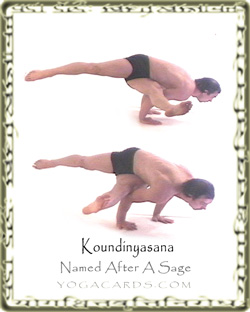YOGA POSTURES ![]() ASANA
ASANA ![]() YOGA POSES
YOGA POSES ![]() YOGA POSITIONS
YOGA POSITIONS
![]()
Koundinyasana
Translation: This yoga pose was named after a sage
![]()
This posture is very challenging. The spine has to be flexible and the ability to laterally rotate it with ease in necessary. The hip abductors and hamstrings have to be flexible too.
![]()

The pose shown requires a lot of arm strength. In this posture the shoulders are aligned horizontally but an easier version of this posture can be performed by allowing the elbow to tuck under the ribs. This posture requires less arm strength but as a result one shoulder dips down.
![]()
Align the foot that is back with the palm or elbow as seen opposite. Extend through the heels, toes or ball points of the toes or do all of these foot positions while holding the pose. Extending through the heels has been taught for many years but there are many benefits to the other variations.
![]()
Try to stretch through the chin. This will stretch the neck, chest and even the abdominal muscles.
![]()
Breathing is hard and the diaphragm is restricted. Take a few short rapid breaths while entering then move to a deeper breath.
![]()
Tips
The pose looks a lot better when the chin is stretched forward but it can block the elements of water and air in the back of the neck. Stretch it forward but after a few breaths allow space behind the neck for the other elements to flow.
![]()
Benefits
This posture increases arm strength and shoulder strength. It also increases the spines ability to rotate. The wrists are strengthened with the proper engagement of the wrists muscles and fingers. The leg abductors in the leg that is extended back are also strengthened.
![]()
![]()
Vinyasa Yoga postures to transition from and to:
![]()
![]()
Adho Mukha Dandasana ![]() Parsva Dandasana
Parsva Dandasana ![]() Chaturanga Dandasana
Chaturanga Dandasana ![]() Astangasana
Astangasana ![]() Cat Flow
Cat Flow ![]() Balasana
Balasana ![]() Salamba Kapotasana
Salamba Kapotasana
Yoga Teacher Tips
This is a hard posture to perform during class. Poses that require a lot of strength but also suppress the abdomin can be harmful. Being in rotation suppresses and compressing even more. There are many spinal twists and many ways to strengthen the arms. Perhaps some alternatives are appropriate in the beginner to intermediate stages of practice. Introduce this pose to advanced practitioners.
![]()









